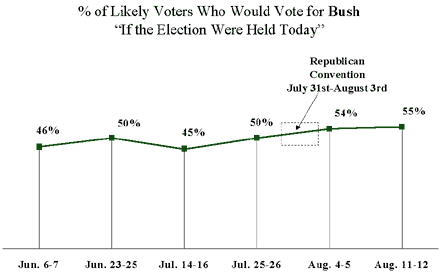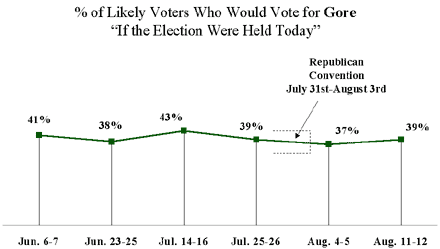PRINCETON, NJ -- The period of time between July 19 and August 20 is one of the most significant of the entire Election 2000 presidential campaign -- at least in terms of creating the potential for major structural changes in the status of the race. Gallup polls have shown definitively over the past 40 years that political conventions have consistently been the most disruptive events in the election process, generating change in voters' preferences for the major candidates as often as not.
Voters usually swing significantly in one direction during or after a particular party's convention. Then they swing right back the other way after the other party holds its convention. In 1988, for example, Gallup's pre-election polling showed a swing toward Michael Dukakis as a result of the Democratic convention, followed by a swing right back to Vice President George Bush as the Republican convention got underway. Bush emerged from the process as the frontrunner -- a position he never relinquished. In 1992, Bill Clinton surged ahead in polls during the Democratic convention (Ross Perot dropped out of the race at that time) and Clinton also retained his lead and went on to win the election.
Thus, beginning with the weekend of July 19th -- when leaks began in earnest about George W. Bush's pick of Dick Cheney for his vice president, followed by the actual Cheney announcement and then the week of the GOP convention, through this past week with leaks of Gore's VP finalist list and the actual selection of Joe Lieberman, and now the week of the actual Democratic convention -- we have undergone what polling history suggests is a natural time of turmoil in voter sentiments about their potential presidential vote "if the election were held today".
It is not so much that hard-core Democrats and Republicans are changing their minds, although some do. Instead, we are seeing volatility among the more loosely attached moderates and independents who find it fairly easy psychologically to change their vote based on the latest publicity and visibility given to the two parties and their candidates.
Among other things, this period of volatility results in changes in specific polls from day to day and from week to week, and differences from polling organization to polling organization among polls taken roughly contemporaneously. This past weekend, in fact, saw the publication of a number of national polls taken by various polling organizations that differed sometimes substantially in what they showed, providing further evidence of the volatility of the current election period. Polls that rely on registered voters, additionally, may show somewhat more volatility than those - like Gallup's - that rely on likely voters, since likely voters by definition have been paying close attention to the race and may be less likely to be swayed by short term events like conventions.
Let's look at what Gallup has found over the last couple of months. Beginning in June, Gallup has conducted six significant polls (Gallup has also conducted several snapshot, or one-night polls).
The percent of the likely voter population which can be estimated to have voted for Bush - if the election were being held at each of the time periods listed below- is as follows:
|
Polling Date |
% of likely voters who would vote for Bush "if the election were held today" |
|
% |
|
|
June 6-7 |
46 |
|
June 23-25 |
50 |
|
July 14-16 |
45 |
|
July 25-26 |
50 |
|
REPUBLICAN CONVENTION JULY 31-AUGUST 3 |
|
|
August 4-5 |
54 |
|
August 11-12 |
55 |
|
Mean |
50 |
|
Range high to low |
10 points |
|
Mean before convention |
47.75 |
|
Mean after convention |
54.5 |

Although there has been some fluctuation from poll to poll, the average of the June and July polls taken before the convention is 6.75 points below the average of the two polls taken after the convention. These data suggest that Bush's percentage of the vote in the actual population of likely voters across the country did increase as a result of the Republican convention.
The likely voter totals for Al Gore did not move as much:
|
Polling Date |
% of likely voters who would vote for Gore "if the election were held today" |
|
% |
|
|
June 6-7 |
41 |
|
June 23-25 |
38 |
|
July 14-16 |
43 |
|
July 25-26 |
39 |
|
REPUBLICAN CONVENTION JULY 31-AUGUST 3 |
|
|
August 4-5 |
37 |
|
August 11-12 |
39 |
|
Mean |
39.5 |
|
Range high to low |
6 points |
|
Mean before GOP convention |
40.25 |
|
Mean after GOP convention, but before Democratic convention |
38 |

As can be seen, Gore's vote in the two polls conducted after the GOP convention fell by only 2.25 points, compared to the average of the four previous, pre-GOP convention polls. In short, while Bush gained more than 6 points, Gore lost a little more than 2 points.
Bush's gains, it turns out, came more from third-party candidates than from Al Gore. The percentage of the votes going to Ralph Nader of the Green Party and Pat Buchanan of the Reform Party have declined from an average of 7.25 (Nader and Buchanan combined) in the four polls before the GOP convention to an average of 3.5 in the two polls since. This type of decline may be a natural function of the attention being paid to the two major parties during this convention time.
Thus, half way through the July 19-August 20 critical period, the data suggest (as polling history would also predict) that George W. Bush has gained in his standings among likely voters, largely because he has converted third-party supporters to move to his ticket, in addition to shifting voters away from Al Gore.
More generally, the structure of the race remains similar to what it has been all year: George W. Bush continues to lead. The data suggest that if the election had been held at any point since January, Bush would most likely have won. However, just as the GOP convention produced an upward movement for Bush, the historic anticipation is that the Democratic convention will move Gore's numbers up. The key problem for Gore is that he is starting at a deficit, and a traditional bounce will move him closer to Bush, but not necessarily to a position of parity or leadership.
Looking Ahead
Suppose for a moment that the next two polls to be conducted after the Democratic convention give Gore the same 6.75 average rise that Bush enjoyed. Using Gore's current two-poll average of 38 (based on his slightly diminished positioning after the GOP convention) as a starting point, Gore would then move to an average of 44.75, or 45% of the vote. Then, assuming that all of Gore's increase comes at the expense of George W. Bush, Bush's average level of support would drop to 47.75, or 48% of the vote. At that point, Gore would certainly be within striking range of Bush, with Bush holding only a 48% to 45% lead, but Gore would not be in the optimal leadership position going into Labor Day that he would want. For Gore, this type of positioning would mean that he would need to hold on to his "bounce," and hope that future developments would continue to erode Bush's lead as the race heads toward the vote in November.
Of course, it is possible that Gore will surpass Bush's gains. A gain of 8 percentage points or more by Gore would begin to move him into the lead, and a gain of 10 points would give him a more solid lead. Some observers have noted that it may be easier for Gore to gain a larger than average convention bounce because more than 15% of Democrats in the latest poll are not voting for Gore, and the convention may be effective in bringing these Democratic voters "home". Additionally, it is possible that more Democrats may move into the category of likely voters if they are energized by the convention, thus countering the normal Republican turnout advantage.
Even if he is behind after the Democratic convention, Al Gore will have at least one more major chance to grab the public's attention-- the debates. The debates sponsored by the Commission on Presidential Debates will be held after the Sydney Olympics this year, in early October. Gore certainly has more experience at national debates than George W. Bush, having debated Dan Quayle in the 1992 election, Jack Kemp in 1996, and Ross Perot in a highly publicized e encounter relating to NAFTA on CNN's Larry King show in 1993. Thus, some Democratic observers are hoping that the debates this year will give their candidate one more chance to move voters into his camp at the expense of George W. Bush.